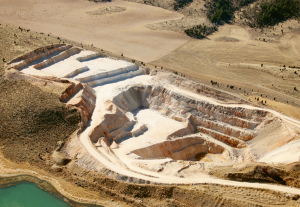Any long-term solution to the projected decline in phosphate supply must involve improving phosphorus use efficiency in crop plants.
In times of rising food prices and global food insecurity it is important to remember the basic needs for productive and efficient agriculture. One of these needs is the use of fertilizer. While much research focuses on the problem of overfertilization and its negative environmental impacts, mostly due to nitrogen runoff, another reason to rethink the wasteful use of fertilizer is that complete fertilizer is a non-renewable resource due to its phosphorus component, an essential plant macronutrient that is almost exclusively mined as the mineral phosphorite, also known as rock phosphate.

Over 70% of global phosphorite reserves are held by Morocco, followed by China with 5%, Syria and Algeria with 3% each, and Russia, South Africa, the US, Egypt and Jordan with 2% each. However, agriculture does not just depend on phosphorite reserves, but on the whole fertilizer production process, which requires a functioning phosphorus supply chain. Production is influenced by political and economic factors such as war and conflict. Despite its vast reserves, Morocco is only the second largest phosphate producer, due to ongoing tensions with Western Sahara and high costs of mining. Therefore, it should be kept in mind that not only are the reserves critical for food security, but that the immediate accessibility of phosphates to farmers is also critical for food security. Global reserves that are accessible at a reasonable cost of mining are important in the long term, but how long will these reserves last?
Geophysicist Marion King Hubbert formulated the concept of peak oil in 1956, reminding us that the planet’s resources are not infinite. Decades later, and attracting much less attention, a similar idea was established for phosphorus, and it was predicted that its peak could be reached globally as soon as 20331. The concept is based on the assumption that increasing demand for a limited resource would inevitably reach a point where the costs to produce more would surpass the profit, leading either to a decline in production or an increase in the price. Such peak predictions have been chronically inaccurate due to the difficulty in estimating existing reserves, and the constant underestimation of human ingenuity and capacity for innovation and exploration. But whether innovation should only be focused on the exploitation side of the balance must be scrutinized.
The demand side of the balance is currently dominated by the wasteful use of fertilizer. As long as its acquisition is cheap enough, there is little pressure for practical innovation; although in theory, some solutions are possible. It was estimated that less than 20% of the phosphorus applied in agriculture contributes to the food that we consume2, with the remainder running off from cultivated land, entering aqueous ecosystems and contributing to eutrophication. Some current efforts to recycle phosphorus focus on the recovery of phosphate that is removed from the land through harvesting, while others focus on reducing the run-off.
In the first category, serious efforts are being made to recover phosphorus from human urine. 50% of dietary phosphorus is excreted in urine and is thus diluted in wastewater. Therefore, there is much interest in the development of novel materials that allow efficient recovery of phosphorus from wastewater3. In Germany, a new sewage regulation was passed in 2017 that stipulates the mandatory recycling of phosphorus from sewage after a transition period of 15 years. However, given that 80% of phosphorus used in agriculture never goes through a sewage plant and that even the other 20% might not be fully recovered, at least not at a reasonable cost, these solutions are chiefly of local importance.
In the second category, efforts are centred towards a more efficient use of phosphorus by crop plants. The aim is to achieve optimal growth and yield with much lower concentrations of phosphorus in fertilizers; a concept that is known as improved phosphorus use efficiency (PUE). Breeding and gene technology are being used to obtain new crop varieties with improved PUE that take up a larger fraction of the applied phosphorus. Since there is a large excess of phosphorus in current fertilizers, there is potentially much room for improvement. However, both breeding and molecular-based biotechnology approaches require the knowledge of relevant target genes that affect phosphate uptake and allocation by the crop plant. Every newly discovered gene with such a function is a valuable step towards improving PUE and reducing the 80% of wasted phosphorus to a lower percentage. In this issue of Nature Plants, Xinlong Xiao, from the Shanghai Center for Plant Stress Biology, and colleagues uncover a mechanism for how phosphate is withheld in roots under phosphate-scarce conditions, allowing enhanced root growth at the expense of shoots.
Slowly but steadily such pieces of information can assemble into a picture of phosphate uptake, signalling and allocation. However, new crop varieties with improved PUE are only part of the solution. The growing gap between scientific progress and practical application needs to be reduced, and knowledge transferred from papers to farmers and governments. What is true for evolution is probably also true for agriculture: a larger diversity of crops and approaches that are actively in use enhance the resilience of the overall system to unexpected fluctuations, as well as to long-term changes including climate change. Unexpected fluctuations in phosphorus supply chains due to conflicts, geopolitical decisions or temporary supply shortages should not be underestimated, as such effects might become relevant long before peak phosphorus.
References
Cordell, D., Drangert, J.-O. & White, S. Glob. Environ. Change 19, 292–305 (2009).
Dawson, C. J. & Hilton, J. Food Policy 36, S14–S22 (2011).
Desmidt, E. et al. Crit. Rev. Environ. Sci. Technol. 45, 336–384 (2015).
Rights and permissions
About this article
Cite this article
Approaching peak phosphorus. Nat. Plants 8, 979 (2022). https://doi.org/10.1038/s41477-022-01247-2
Published:
Issue Date:
DOI: https://doi.org/10.1038/s41477-022-01247-2
This article is cited by
-
Phosphate starvation response precedes abscisic acid response under progressive mild drought in plants
Nature Communications (2023)
